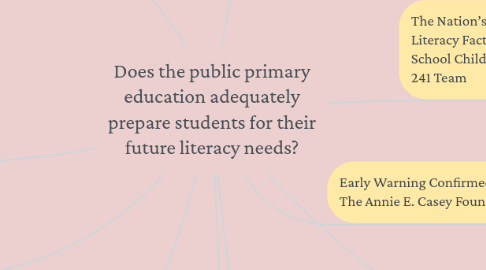
1. Writing across the Curriculum
1.1. Writing Across the Curriculum: What, How and Why By Deva Dalporto
1.1.1. "...is designed to boost children’s critical thinking skills by requiring them to write in all of their classes—from math to social studies to science—and not just in language arts."
2. Multimodality
2.1. Connecting, Creating and Composing: A Shared Multimodal Journey By Margaret B. Krause
2.1.1. "Multimodal literacy is “the simultaneous reading, processing and/or writing, designing, producing and interacting with various modes of print, image, movement, graphics, animation, sound, music and gesture”"
3. Creativity
3.1. the use of the imagination or original ideas, especially in the production of artistic work.
4. Crisis Point: The State of Literacy in America By The Room 241 Team
4.1. "Literacy is an authentic and complex social justice issue as it determines many of the factors that contribute to a student’s future quality of life."
4.1.1. "Those who are illiterate can lack access to information, are excluded from making choices about their rights or government through voting, and have fewer opportunities for employment. Illiteracy keeps people trapped in a cycle of poverty and subjugation, limiting life choices and making it difficult to achieve social mobility."
4.2. Proliteracy: The Facts on the Adult Literacy Crisis
4.2.1. "Since 1983, more than 10 million Americans reached the 12th grade without having learned to read at a basic level."
5. Why American Students Haven't Gotten Better at Reading in 20 Years By Natalie Wexler
5.1. "The best way to boost students’ reading comprehension is to expand their knowledge and vocabulary by teaching them history, science, literature, and the arts"
5.1.1. Many students are unable to perform well on standardized testing because of their poor comprehension skills. If writing and reading were across the curriculum from the very start of school students would have a much better comprehension ability and a lot more practice writing in different ways.
5.1.1.1. The reason so many students are illiterate is because they were passed along through school never actually obtaining those comprehension and writing skills.
6. The Nation’s Reading And Literacy Facts and Statistics For School Children byThe Room 241 Team
6.1. “Fifty percent of unemployed youth ages 16-21 are functionally illiterate with no prospects of obtaining good jobs, according to U.S. government researchers.”
6.1.1. “...more than 37 percent of fourth-graders are not reading at the basic level in their grade, and 26 percent of eighth-graders are not reading at their basic level. The Family Literacy Centers also predicts that if a child is not proficiently reading by the fourth grade, he or she will have a 78 percent chance of not catching up with classmates.”
6.1.1.1. If students do not learn how to read and write in the first few years of schooling they will most likely never learn
7. Early Warning Confirmed By The Annie E. Casey Foundation
7.1. "82 percent of fourth-graders from low-income families — and 84 percent of low-income students who attend high-poverty schools — failed to reach the “proficient” level in reading on the National Assessment of Educational Progress (NAEP)."
7.1.1. "In 2012, Donald Hernandez reported that “living in a high-poverty neighborhood exacerbates the effects of poor reading skills and family poverty.”
7.1.1.1. Poverty Stricken communities, homes, and/or schools largely decrease the chances of being prepared in reading and writing. Because of this the rate of dropouts is extremely high.
8. Literacy Challenges for the Twenty-First Century By Richard Murnane, Isabel Sawhill, and Catherine Snow
8.1. "the literacy skills of Hispanic and black children are significantly lower, on average, than those of non-Hispanic white children."
8.1.1. "One major difference between children likely to become good readers and those likely to struggle is vocabulary knowledge."
8.1.1.1. "The reading gaps between black and white children are especially troubling because not only are they evident when children start school but they grow larger during the school years."
9. "As early as age three, middle-class and disadvantaged children display enormous differences in the size of their vocabulary, because they have had differing experiences with conversations from which they can learn new things"
10. U.S. Education: Still Separate and Unequal By Lindsey Cook
10.1. "On average, schools serving more minority populations have less experienced, lower-paid teachers who are less likely to be certified."
10.1.1. Less experience and less certified teachers forces many students to have a poor education.

